The Nordic/Scandinavian physical stereotypes are as cliche as they are well-known—the stereotypical Scandis are expected to be a bunch of tall, blonde-haired, and blue-eyed Vikings in most people’s minds—but can those stereotypes actually be true in modern-day Scandinavia?
Stereotypical Scandinavian traits and facial features have since the early 20th century included straight, blonde hair; blue eyes; tall figure; a straight nose; thin lips; and non-prominent cheekbones, according to Werner & Björks 2014 book Blond and Blue-eyed.
Peter Frost also supports this in his study titled European hair and eye color; finding that at least 60% of Scandinavian people have a light head of hair, and at least 50% have light eyes.
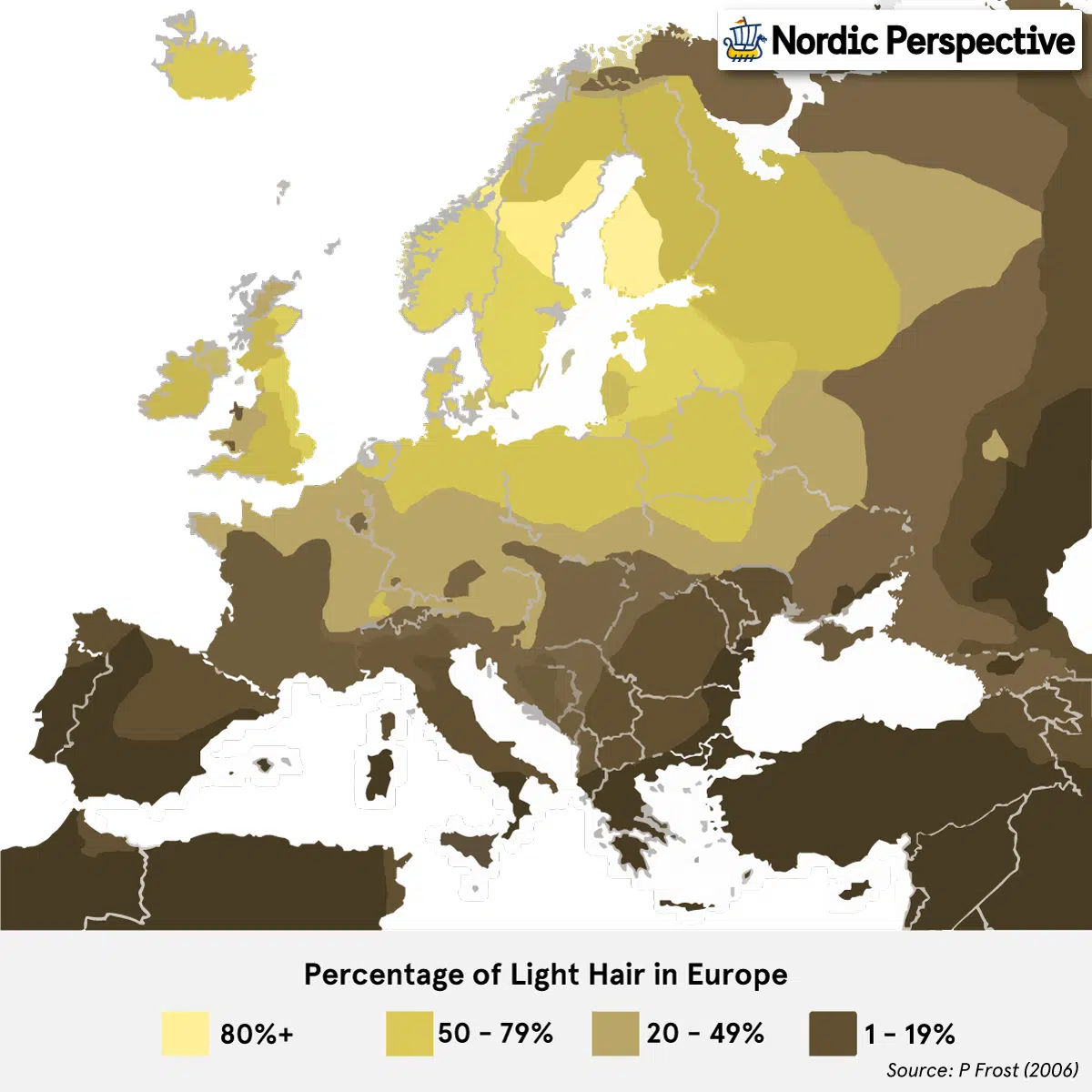
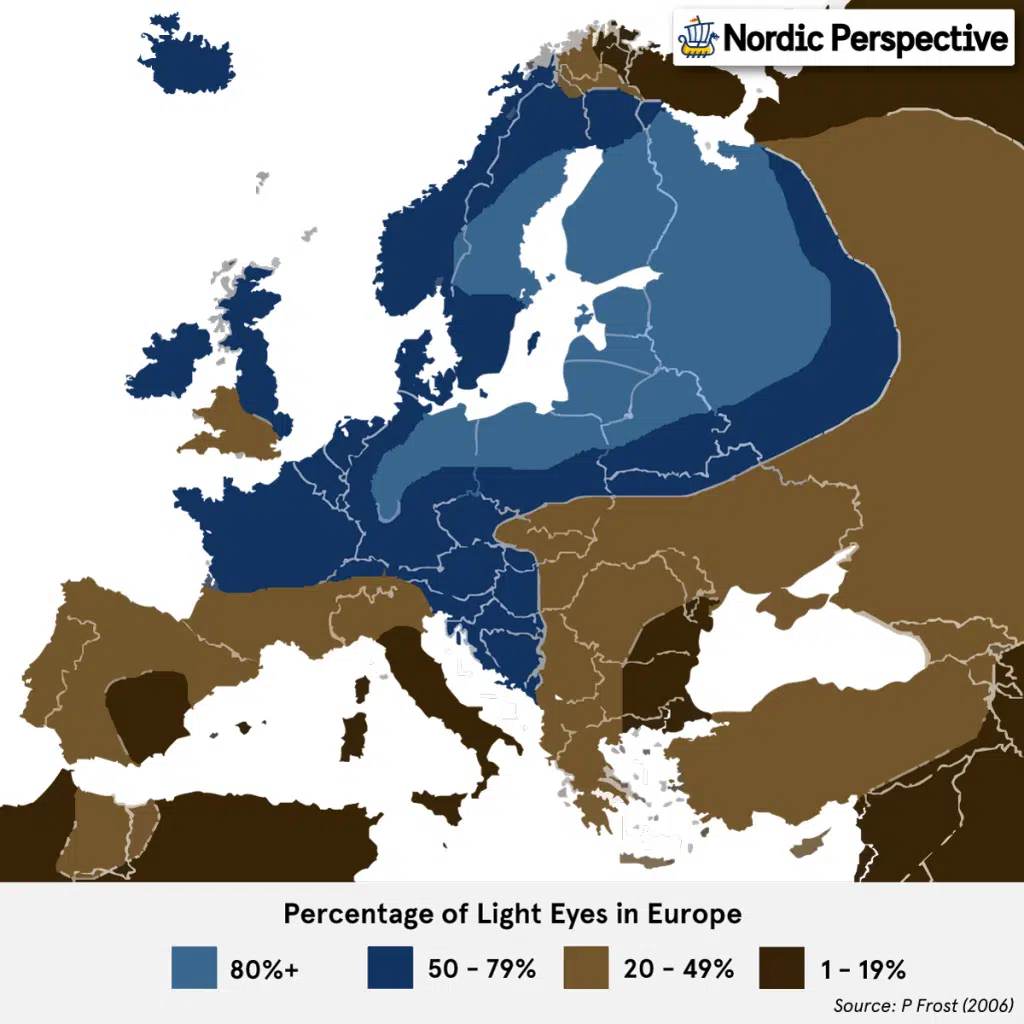
This does not mean that all Scandinavians look like this, but it does mean that this is the common view that most people to this day hold on what it means to “look Scandinavian”, including in the Scandinavian countries.
So What Do Scandinavian People Actually Look Like?
Scandinavians have been generally more blond and blue-eyed than the rest of the world for a long time; from the Vikings—who were “blond in their majority” according to researchers at the University of Copenhagen—to present-day Scandinavians who mostly have light hair and eyes (Lock-Andersen 1999).
Naturally, I wanted to see if this data held up based on my own experience, so I gathered all the hair and eye colors of 103 family members and friends who currently live in or around Malmö, Sweden (one of the more culturally diverse cities in Sweden I should add). I then categorized the colors as either light or dark:
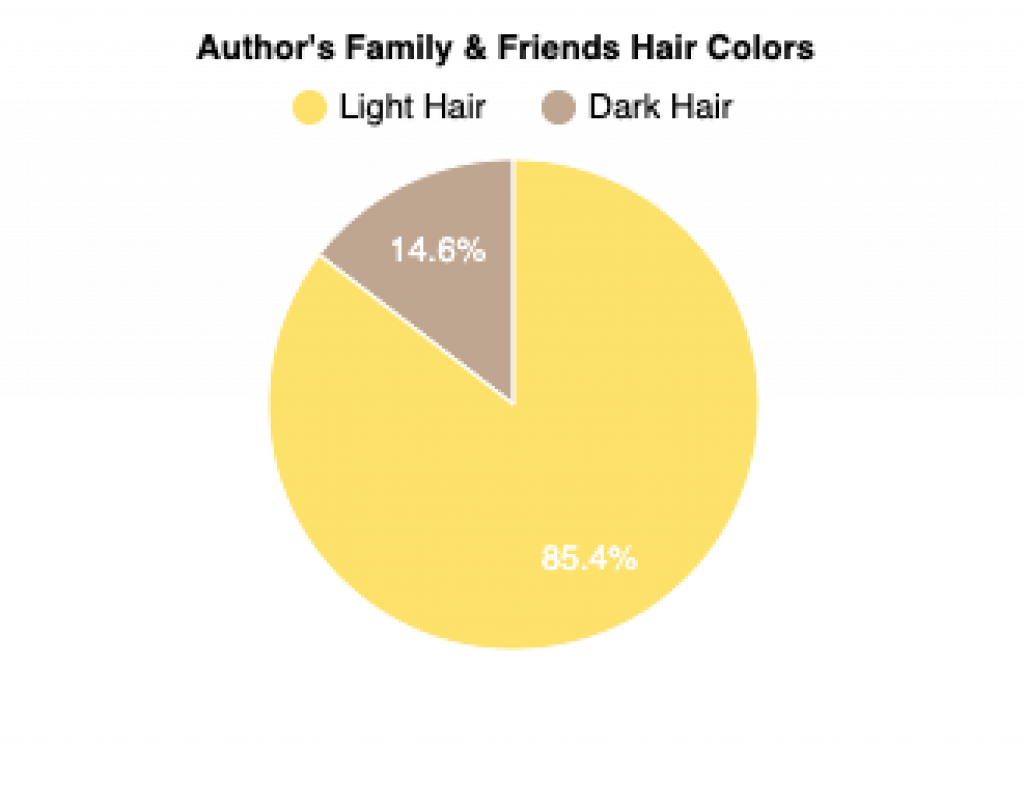
Source: Nordic Perspective (2025)

Source: Nordic Perspective (2025)
In other words, 85% of my friends and family in southern Scandinavia have light hair (ranging from blonde to light brown), and 75% have light eyes (blue, green, hazel, or grey).
This data may not be representative of the Nordic region as a whole, but at least it gives you an insight into what actual Scandinavian people look like in 2025.

So the cliché blue-eyed and blonde Nordic stereotype seems to hold true then, but where do these physical traits come from and why do they still seem to have a strong presence in the Nordics?
A History of Scandinavian Looks
To find out the origins of the light hair/light eye color combination we need to look at where people in Scandinavia came from originally, and how they looked (based on DNA samples and analysis). Let’s dig a little deeper and look at what we know about the first Scandinavians:
The First Scandinavians Where Dark-skinned and Blue-eyed
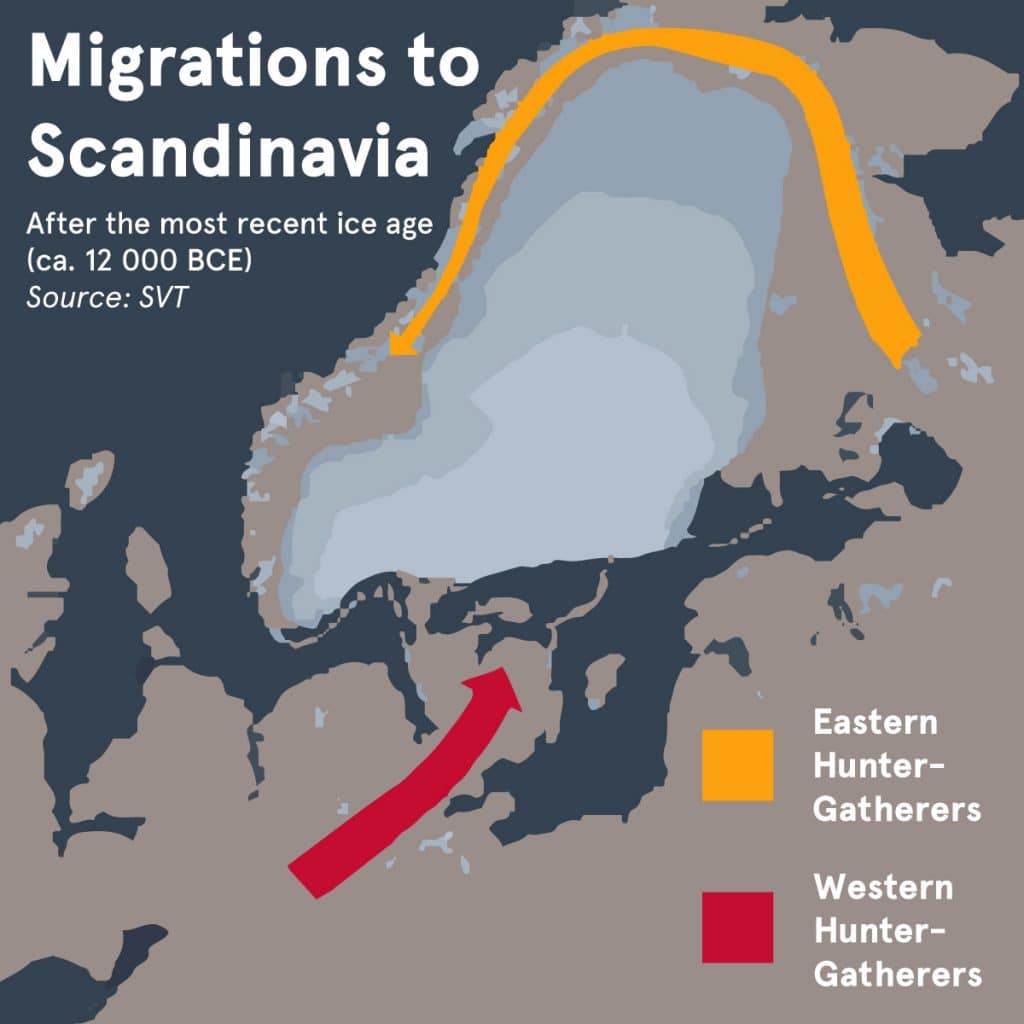
The First Scandinavian People
The first inhabitants of the Scandinavian peninsula came from the south with darker skin and blue eyes (known as Western Hunter-Gatherers), later joined by migrants from the east (known as Eastern Hunter-Gatherers) who had lighter skin but darker eyes.
During the following centuries, these two hunter-gatherer groups intermingled and produced one of the most diverse populations of the stone age, with a population at the time of about 10 000 to 20 000 in all of Scandinavia.
Scandinavian Hunter-Gatherers
The Scandinavian Hunter-Gatherers lived in the region between 8000 BCE and 2800 BCE, and have been found to have had mixed eye colors (ranging from blue to light-brown), mostly dark hair (with the odd blondes present), and intermediate skin color (somewhere in between dark and light) with the odd light-skinned individual also present.
The Anatolian/Syrian Farmers
The first farmers—originating from Anatolia and Syria and commonly called Early European Farmers—start arriving to Europe and Scandinavia around 4 000 BCE with powerful new knowledge and tools, competing and wiltimately fusing with the original inhabitants.
The Black Sea Steppe Herders
Another wave of migrants came into Scandinavia around 4800 years ago from the Russian steppes, originating from the northern shores of the Black sea and commonly called the Western Steppe Herders. This wave of primarily herders eventually fused with the current habitants (I see a pattern here…) to produce the so-called Battle Axe culture group in Scandinavia, establishing themselves and flourishing in modern-day Denmark, Sweden and Norway.
The Battle Axe Culture
The new Battle Axe culture that slowly spread and took over the Scandinavian region is thought to have been a bit more individualistic and was known for how their men were buried with their big battle axes.
The Nordic Bronze Age People
When the Battle Axe culture group fused with the groups already present in Scandinavia this eventually spawned the Nordic Bronze Age people, who are seen as the ancestors of all Germanic people.
In summary, it seems Scandinavians from before the Viking age looked a bit different from today’s Scandis, with multiple migration waves that settled in the region up until the iron age being quite diverse in looks and origins.
ℹ️ Curious how Vikings actually looked like? I’ve written an article where I go into detail about Viking traits and looks, so if you want to find out more about Vikings looks go take a look.
Let’s keep digging and see exactly how different ancient Scandinavians were from us modern Scandis.
How do the modern-day Scandinavians compare to their ancestors?
Today’s Scandinavians are about 65%-80% “Scandinavian” as far as DNA goes, with the rest of the DNA being primarily Finnish, Western European, British, Eastern European, and Irish (all are > 1%).
DNA studies have also shown that around 40% of modern Swedish men have their roots in bronze age migrations from the Russian steppes, 40% from bronze age migrations via northern Germany, and 20% from before the bronze age migrations.

Still, genealogists from Stockholm university believe modern Swedes are most closely related to the hunter-gatherers from the so-called Pitted Ware culture when it comes to physical appearance. DNA analysis from specimens from this period has shown people with dark hair, a mix of light and dark skin, and most likely blue eyes—which sounds like a lot of modern-day Scandinavians I know.
So what do the rest of the Nordics look like?
In the rest of the Nordics (namely Iceland, Finland, and the Faroe Islands) the people tend to look very similar to the Scandinavians, with especially Finland having a very large majority of their population being light-haired (blonde, light-brown, red) and light-eyed (blue, green, grey) according to Peter Frost.
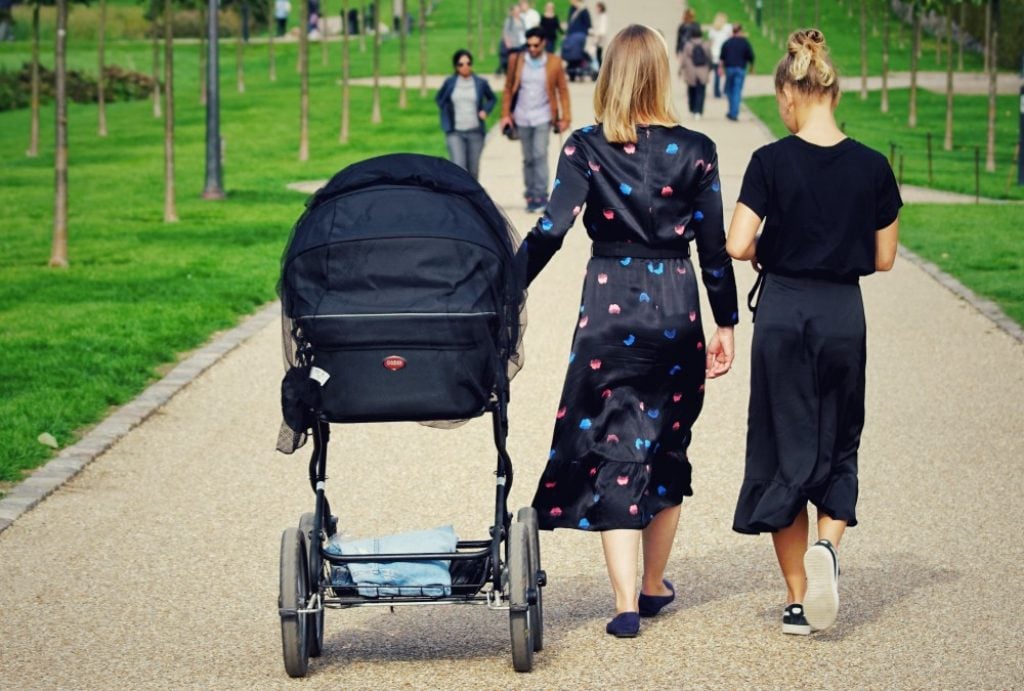
Nordic and Scandinavian Physical Traits Today
All of our knowledge about pre-Viking Scandinavians comes from DNA analysis and theories, but for an idea of how modern-day Swedes, Danes, and Norwegians look like we can turn to some cold hard data and settle some standard questions right off the bat.
Are Scandinavian People tall?
The average height of both males and females is high in Scandinavian countries when you look on a global scale, with the Nordic countries all ranking among the tallest 20 countries, and all with a male average height over 180 cm (5 ft 10⅞ in).
According to a 2020 study published in The Lancet, Danes are the 4th tallest people in the world, followed by the Icelandic in 6th, the Swedes in 12th, Norwegians in 13th, and finally the Finns as 17th tallest people in the world.
Let’s take a more detailed look at how the Nordic people—both male and female—stack up against each other and the world when it comes to height:
| Country | Female avg. height | Male avg. height | Global rank |
|---|---|---|---|
| Denmark | 169 cm / 5 ft 6 in | 182 cm / 5 ft 11½ in | 4th |
| Iceland | 168 cm / 5 ft 6⅛ in | 181 cm / 5 ft 11¼ in | 6th |
| Sweden | 167 cm / 5 ft 5¾ in | 180 cm / 5 ft 10⅞ in | 12th |
| Norway | 166 cm / 5 ft 5⅜ in | 180 cm / 5 ft 10⅞ in | 13th |
| Finland | 166 cm / 5 ft 5⅜ in | 180 cm / 5 ft 10⅞in | 17th |

The Danish are the tallest people in the Nordics, with the average male Dane reaching 182 cm / 5’12”, followed by the Icelandic men at 181 cm, and finally the Swedes, Norwegians, and Finns at 180 cm.
To sum it up, the average Swedes, Norwegians, Danes, Finns, and Icelanders are all very tall compared to the rest of the world.
Let’s also look at how Nordic people as a whole compare to people from other regions of the world in height:
| Rank | Region | Female weighted avg. height | Male weighted avg. height |
|---|---|---|---|
| 1st | Baltics | 167.54 cm / 5 ft 5¾ in | 180.44 cm / 5 ft 10⅞ in |
| 2nd | Nordics | 167.03 cm / 5 ft 5¾ in | 180.44 cm / 5 ft 10⅞ in |
| 3rd | Central Europe | 165.72 cm / 5 ft 4⅞ in | 179.70 cm / 5 ft 10½ in |
| 4th | Benelux + France | 165.10 cm / 5 ft 4⅞ in | 179.21 cm / 5 ft 10½ in |
| 5th | British Isles | 164.00 cm / 5 ft 4½ in | 178.07 cm / 5 ft 10⅛ in |
| 6th | Southeastern Europe | 164.88 cm / 5 ft 4½ in | 177.57 cm / 5 ft 9¾ in |
| 7th | US + Canada | 163.21 cm / 5 ft 4¼ in | 177.10 cm / 5 ft 9¾ in |
| 8th | Southern Europe | 162.88 cm / 5 ft 3¾ in | 176.58 cm / 5 ft 9¼ in |
| 9th | Southwestern Europe | 162.64 cm / 5 ft 3¾ in | 176.57 cm / 5 ft 9¼ in |
After adding up the individual country data and calculating a weighted average for each region (i.e. an average adjusted for the population of each country within the region), we can see that the Nordic and Baltic men are the tallest in the world, but as the Baltic ladies are slightly taller (0.5 cm / 0.2 in) than their Nordic sisters, the Baltics narrowly takes the prize as the tallest region in the World in front of the Nordics.
It should also be added that the countries around the Dinaric Alps in Western Balkans would place in the top if S.E. Europe had been split up into smaller sub-regions, as these countries are among the tallest in the world.
How are Scandinavians (Swedes, Danes, Norwegians) so tall?
Scandinavians and other Europeans are tall on average primarily due to a vastly improved diet from the mid-1800s and onwards according to Lars Werdelin, a professor in paleozoology at the Swedish Museum of Natural History.
It should be noted that human length, in general, is determined by a mixture of nature (genes) and nurture (diet), and there are also regions of the world that are believed to have a taller or shorter average height due to primarily genetic reasons—such as the short Pygmee people of central Africa, and the tall Dinka people of South Sudan.
Are Scandinavians and Nordics especially strong?
The average Scandinavian isn’t necessarily stronger than any other given person in the world, but there has been a very high amount of “World’s Strongest Man” contestants and winners from the Nordic and Scandinavian countries, with Nordic men landing in the top 3 a whopping 30 out of the 44 years the competition has taken place (that’s a 68% chance of at least one Nordic in the top 3).
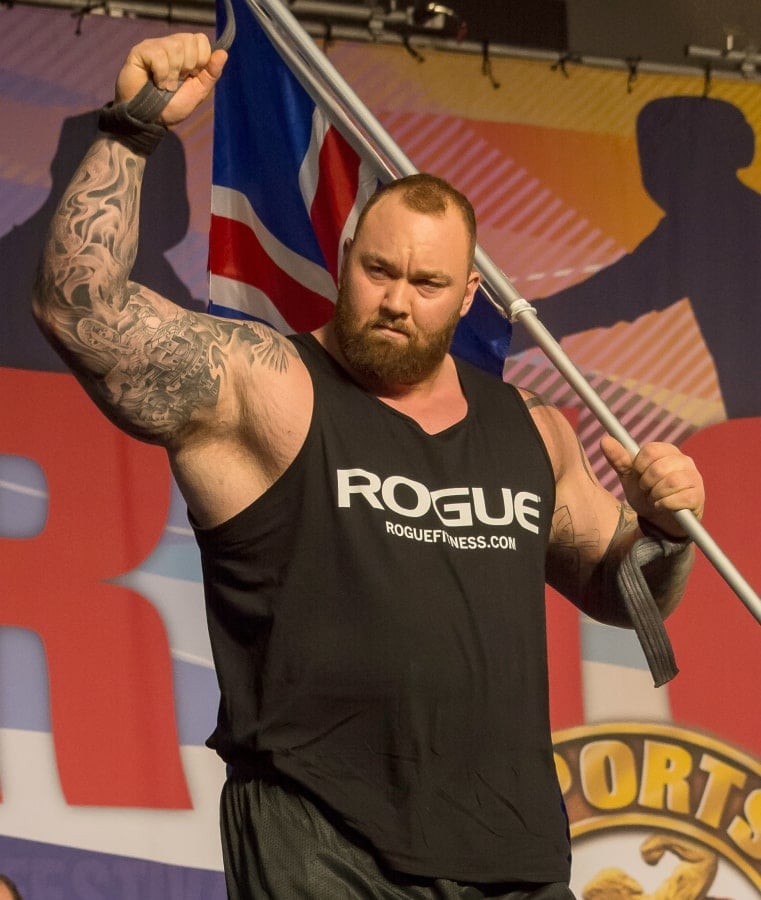
Notable Nordic winners of the strongman competition include Iceland’s Hafþór Júlíus Björnsson (of Game of Thrones fame as Ser Gregor Clegane/The Mountain) and Sweden’s Magnus Samuelsson (who features in the series The Last Kingdom as the Viking band member Clapa).
I’ve written an analysis of The Last Kingdom if you want to find out if it’s worth watching or not.
How do Nordic people get so strong?
Outside extreme muscle competitions, the fact that Scandinavians are among the tallest people in the world suggests some additional muscle mass along with the extra height. Scandinavian people also have traditionally had a diet rich in protein, fat, and carbs (crucial for significant muscle growth).
When you couple this with the opportunity to spend time on athletic endeavors and have access to a protein-rich and generally plentiful diet — it is easier to see why some Nordic people tend to generally do well in muscle competitions.
It should be added that those athletes are extreme outliers, and not at all representative of the general Nordic population.
Scandinavian and Nordic Eyes
As we’ve established, most Nordic people today have brightly colored eyes, with some areas reaching up to 80% of the population (P. Frost 2006).
This is also illustrated in reality when we look at the eye color of Swedish governors after the 2022 election, with 18 out of 21 (~86%) having brightly colored eyes; 16 pairs of blue eyes (~76% of total), and 2 pairs of green (~10% of total).
So other than the color of the eyes, let’s look at which other eye characteristics are unique or interesting in the Scandinavian region.
Are Epicanthic folds common in Scandinavia?
Although it isn’t exactly common with Epicanthic folds among the Swedish population, Swedes with Sami heritage (famous examples include Jens Byggmark, Anja Pärson and Ingemar Stenmark), and from the northern parts in general, have higher rates of Epicanthic eye folds.

Scandinavians as a whole are part of a group of ethnicities (along with Finns, English, Irish, Estonians, Latvians, Lithuanians, Polish, Hungarians, and Russians) where the Epicanthic fold is occurring more than in other European populations, but still at a much lower frequency than for example Asian ethnicities.
According to Swedish scientific magazine Illustrerad Vetenskap, this type of “microevolution” developed as a response to the cold and snowy climate in the Arctic region, as the fatty fold isolates against freezing temperatures and shields the bright reflection of the snow somewhat.
Do Scandinavians have hooded eyes?
Hooded eyes are prevalent in the Scandinavian population, and studies have shown that about 18 percent of northern Europeans have so-called “sagging eyelids” (which is related to hooded eyes but more specifically excess skin over your eye that may or may not disrupt your vision).
I’ve noticed that surgeons in Sweden, Norway, and Denmark all offer surgery to counteract this condition in case it disrupts your eyesight, or as an elective procedure for cosmetic reasons, and this procedure isn’t as commonly seen in other areas of the world.
What is Scandinavian Hair Like?
It is estimated that at least 50% of Scandinavians have a light hair color, with some regions in Sweden, Finland and Norway reaching 80%. This means Scandinavian hair mostly fall into these categories:
| Hair color | Example |
|---|---|
| Platinum |  |
| Cassia |  |
| Golden Blonde |  |
| Light Blonde |  |
| Blonde |  |
| Dark Blonde |  |
| Auburn |  |
| Light Brown |  |
So Scandinavian hair color is mostly light in character, but what types of characteristics does Scandi hair have?
According to a Popular Science Monthly study, most Scandinavians have wavy hair, with some parts of northern Scandinavia having more coarse/straight hair.
Furthermore, it has been observed that northern Europeans in general also have a much higher frequency of a specific genetic trait that is linked to straight hair.
Do Scandinavians have curly hair?
Scandinavians do have curly hair, but as we’ve established most of them have wavy or straight hair. The amount of curly-haired people in the Nordics is furthermore a much lesser part of the population compared to the rest of Europe.
This is according to genetic research by Medland et al. published in The American Journal Of Human Genetics.
Essentially, this means you will likely not meet as many curly-haired Scandinavians as you would southern Europeans or Americans for example.

Do Scandinavians have thin hair?
Scandinavian people do not have a very high prevalence of the EDAR gene, thought to be connected with thicker hair (among other traits). Research surrounding the EDAR gene indicates that Scandinavians (along with most Europeans) generally have thinner hair, than for example East Asians and Native Americans.
Do Scandinavians have red hair?
Between 1-10% of the population of Scandinavia have red hair according to studies that have mapped out the so-called “red hair genes”. Some regions have more than 10% redheads, while others only have around 1-3%.
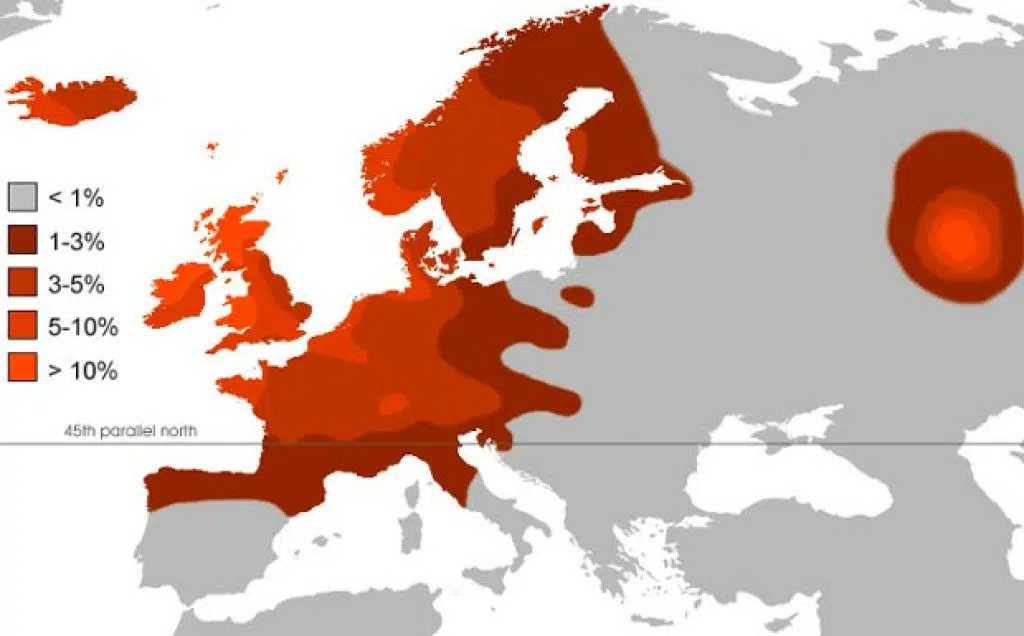
Western Norway has almost as many redheads as the British isles (who win the red hair race by a mile), whereas southern and northern Sweden barely has any.
During the Viking Age, DNA analysis of skeletal remains suggests that the majority of Danish Vikings had red hair, so it seems to have been a prevalent trait in the region for a long time.
Do Scandinavians have natural white or platinum blonde hair?
Natural platinum blonde or near-white hair occurs occasionally among the population in Sweden, Denmark, Norway, Finland, and Iceland, primarily among children (as hair tends to darken with age).
Very few adult Scandinavians have natural platinum blonde hair, but plenty has achieved this hair color by means of artificial coloring (as in the rest of the world).
Even the Vikings were known for bleaching their hair, although the main reason to do so may have been primarily to kill hair lice. Read more about that in my article about Viking Looks!
Do Scandinavians have a lot of body hair?
Over 70% of male Scandinavians have some form of body hair (androgenic hair), which is among the highest rates in the world (along with Mediterranean men). Below the neck, this body hair is generally concentrated on the arms and legs in the Nordics.
This can be compared to the Mediterranean region, where it’s concentrated on the chest and back instead.
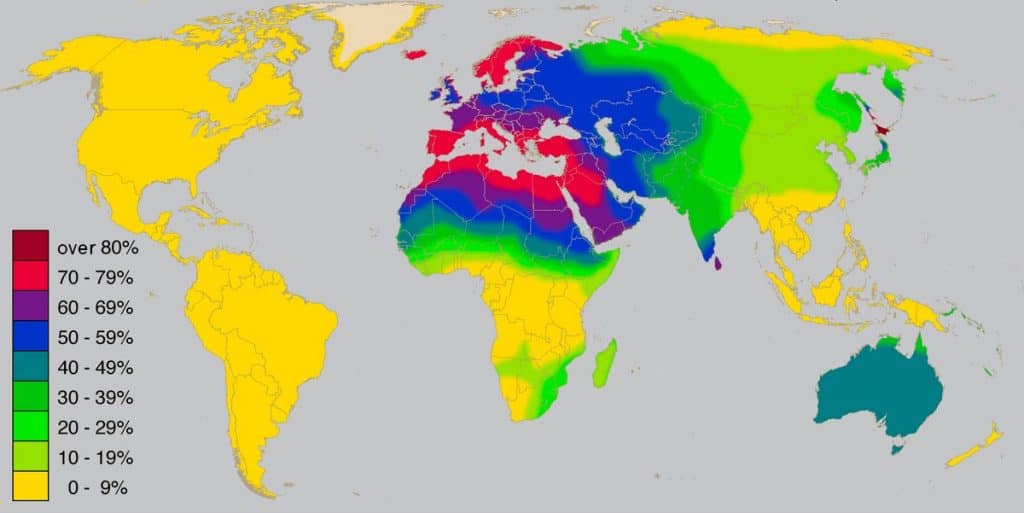
Do Scandinavians have a lot of facial hair?
Studies show that most Scandinavian men are generally able to grow a full beard if they choose to do so, which of course not everyone does. That said, beards are currently fairly popular in the Nordics, as they were during the Viking Age (when insulting another man’s beard could lead to death).
To elaborate on this, facial hair is included under the term “androgenic hair”, so based on data from the American Journal of Physical Anthropology, we see that over 70% of Nordic men (along with Mediterranean men) can grow a beard or mustache (which is well above the global average).
Furthermore, according to a 2016 study published in Wiley, people of European origin generally have a facial hair growth pattern concentrated around the upper lip, cheek, neck, and chin, so it can be assumed that most Scandinavians also are able to generally grow what’s considered a full and thick beard.

Scandinavian skin
Do Scandinavians have freckles?
Since freckles are thought to be connected to the same genes as red hair, we can assume that between 1-10% of the Scandinavian population—again depending on where in Scandinavia you are—has freckles, which means they are also more sensitive to UV light.
The prevalence of this gene on the Norwegian west coast is thought to be linked to slaves from Ireland and Scotland being brought to Scandinavia. Depending on which combination of the genes you have, you will develop either red hair and freckles, only red hair, or only freckles.
Why do Scandinavians tan well?
There are a few theories on why people from Scandinavia, and the Nordics in general, can be light-skinned under low UV conditions (i.e. Nordic fall/winter), but also get a darker tan under high UV conditions (i.e. Nordic spring/summer):
- Scandinavia before the bronze age had the most genetically diverse population in Europe, with the original darker skinned people being present much longer in Scandinavia compared to the rest of Europe (where the light-skinned farmers pushed away the dark-skinned hunters almost entirely). The theory is that this has had a long-term effect on the genetical makeup that determines skin color and tanning ability in the Scandinavian region.
- The further north you live, the less sunlight you get during the colder part of the year. However, people living close to the arctic circle are also exposed to extremely high UV exposure levels during the warmer half of the year (on par with Australia which is notorious for high levels of skin cancer) due to the ozone layer being thinner around the poles. In order to survive the UV-bombardment during summers as well as the lack of sunlight in the winters, the skin of Scandinavians have needed to be adaptable.
- Throughout Scandinavian history the people in the region have had a diet very high in Vitamin D due to a high amount of fish present in the diet. So the theory is that on top of any Vitamin D you’d get from the sun, Scandinavians have also stocked up on it via their fish intake. High levels of Vitamin D produces more melanin, which in simple terms enables skin to tan instead of burn.
Are Scandinavians dark-skinned?
First off, there are plenty of people with darker skin in today’s Scandinavia, but they generally have more than just Scandinavian heritage in their family.
Second, early Scandinavian ancestors are thought to have been dark-skinned, but after mixing with other populations and adapting to the geographical area this trait eventually disappeared.
Third, Scandinavians do tend to tan and get olive-skinned in the summer, which is due to a mix of genetic makeup, unusually high UV exposure levels, and a diet generally high in Vitamin D.
Scandinavian facial features
Do Scandinavians have big noses?
Scandinavians do not have particularly large noses, as Northern Europeans tend to have more narrow noses than people in warmer climates, as an adaptation to the cooler climate. Though differences in size are generally bigger between men and women than between different ethnicities.
Do Scandinavians have high cheekbones?
There are plenty of famous Scandinavians with notably high cheekbones, a trait which is commonly passed down in the Nordic region through families with Sami heritage. Among the Sami people (hailing from Northern Scandinavia), high cheekbones are very common. That said, it’s not a defining trait shared by a majority of Scandinavians.
People from all over the world with high cheekbones are often seen as attractive by today’s standards, with Swedish beauty contestant Ida Ovmar as one recent example where it’s worked out in her favor.
Ovmar has even been accused of having undergone plastic surgery due to her high cheekbones, a claim she rebuffs by simply pointing to her Sami background (which seems plausible judging by the picture below to the left).
Other famous Scandinavians with high cheekbones include Fredrik Ljungberg (pictured below to the right), Mads Mikkelsen, Tim “Avicii” Berg, and Viggo Mortensen.

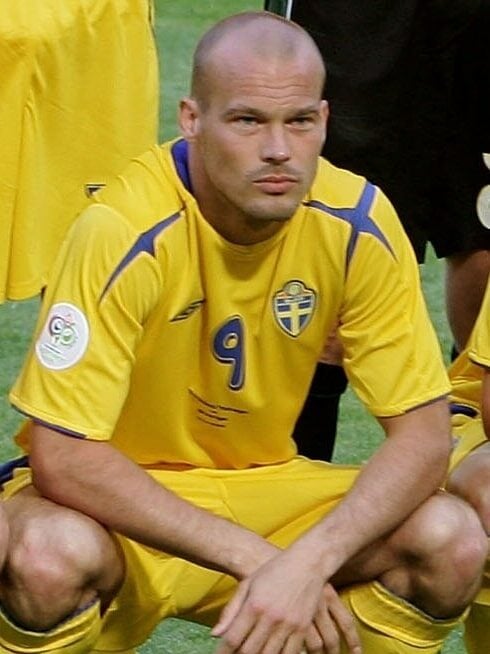
High cheekbones weren’t always seen as a positive trait in the Nordic region though, as it was fairly common for the Germanic Scandinavians to look down upon the Finno-Ugric Samis as less civilized, at least up until the late 20th century.
As such, it was common that people wanted to hide their Sami heritage, with some even being ashamed of typically Sami features such as high cheekbones and wider eyes (SvD 2012).
Are Scandinavians seen as unusually attractive?
Whether the Scandinavian beauty myth is real or not is hard to say, but Nordic magazine The Local listed “Beautiful Women” and “Handsome Men” among the top 10 things US expats notice after they’ve lived in Sweden for a while.
So there is at least something to the myth from a North American perspective (beauty standards differ around the world, after all).
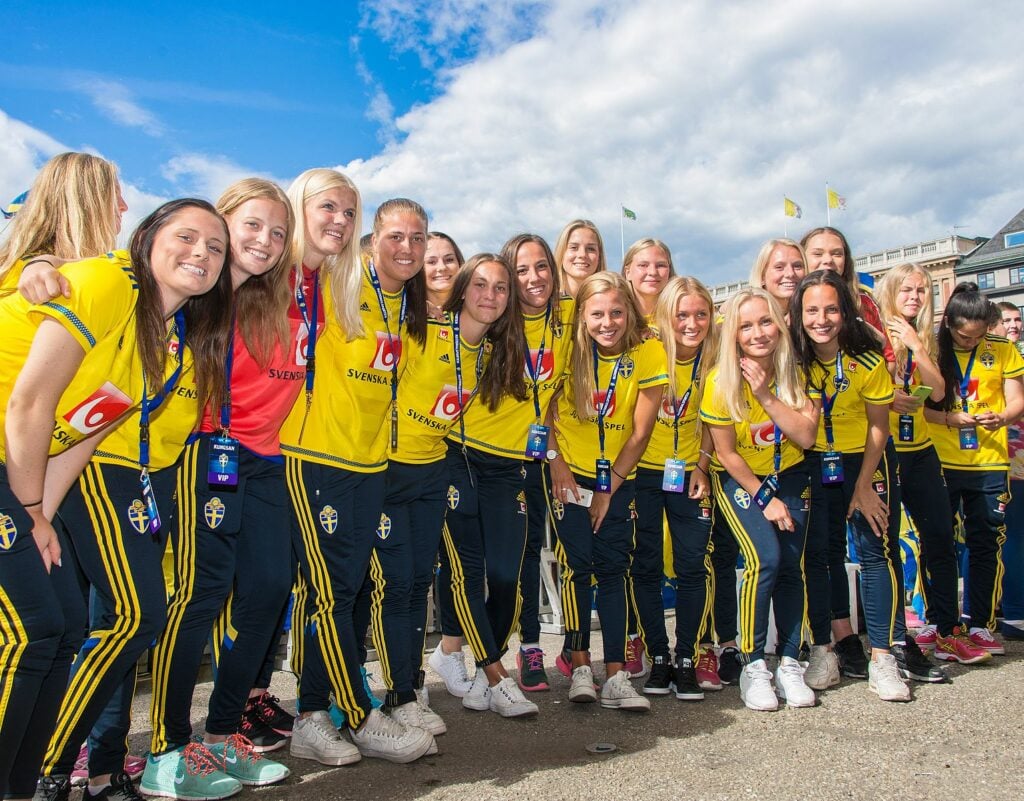
Scientifically speaking, there are a couple of factors that could play in the Scandinavians’ favor as far as sexual selection and attractiveness go:
- Height: As mentioned, Scandinavians and Nordics are on average fairly tall, which is a trait that makes you stand out, quite literally. A study following 100 000 dutch men (Proceedings of the Royal Society B 2015) found that the taller men on average fathered more children than the shorter men, and although it was only a difference of 0.24 children per man, it seems to at least be a factor at play in sexual selection.
- Athleticism: Swedes seem to exercise more than the average person both as children (International Journal of Pediatrics 2020) and as adults (The Local 2014) according to studies and surveys mapping physical activity, something that invetiably leads to higher levels of athleticism, which in turn is seen as a favorable sexual trait in most cultures.
- Eye Color: There seems to be a correlation between how rare an eye color is and how attractive it’s deemed to be, and since at least 50% of Scandinavians (and up to 80% in certain areas) have light eyes (which are among the rarest), one could assume these bright eyes could help out a little as far as perceived attractiveness goes simply because they are rare.
- Hair Color: It’s boring and overdone, but the “Sexy Blonde” cliche does unfortunately seem to have some legs to stand on, partly due to a heavy media bias toward portraying blondes as attractive, but also due to blonde hair being less common, and thus deemed more attractive as per the previous point.
I want to point out that beauty is entirely subjective, and what is considered attractive for some may not be for others. There are no scientific studies suggesting Scandinavians, or any other people for that matter, are considered more attractive than others.
Rather, humans around the world generally consider reproductive factors such as waist-to-hip ratio and other indicators of fertility and health as “attractive”, rather than a specific eye/hair/skin color or similar.
How Nordics and Scandinavians see each other
The Nordic people as a whole really like the Swedes and Norwegians. A survey by Hotels.com and Match.com asked 5000 Nordic singles in 2014 which Nordic country has the most attractive people, and here are the results:
- Sweden
- Norway
- Denmark
- Finland
Singles in Norway, Denmark, and Finland all voted for Swedes as the most attractive (you could not vote for your own country), while the Swedes overwhelmingly seem to prefer Norwegian women and men. The dating site isn’t active in Iceland so the Icelanders were not part of the survey.
However, a survey done by the Swedish Institute in November 2020 do point towards the Swedish image being affected negatively during the 2020-2021 pandemic.
Although the rest of the Nordics generally view Sweden in a positive light still, there has been a slight shift towards more people having a more negative image of Sweden and Swedes lately.
ℹ️ If you’re curious about how exactly Nordic people communicate with each other, I’ve written an article where I go into detail about which languages each Nordic nationality actually uses when communicating with fellow Nordics.
Quick Answers
Do Scandinavians have Neanderthal DNA?
All living humans who descended from Africa have about 2% Neanderthal DNA, and this includes Scandinavians. The two species met and started having reproductive relationships in modern-day Israel some 60 000 years ago, before ultimately clashing and resulting in the demise of the Neanderthals.
Final summary:
When it all comes down to it the classic Nordic/Scandinavian stereotype seems to hold true still. Most people from the Nordics have light eyes and hair, and are quite tall compared to other nationalities.
Whether these traits stem from a diverse pre-bronze age population, geographical conditions, or the modern diet of the region as a whole is hard to say, but they all likely played some part at least.
For another deep-dive into Scandinavian looks, I’ve plowed through massive amounts of archaeological objects and DNA analysis to find out how Vikings actually looked (how big they were, how they wore their hair, where they came from, their hair and eye color, etc.):
By the way, if you'd like to connect to your inner Scandinavian with some stylish prints and clothing, I've created a collection of high-quality and authentic Nordic posters and apparel.
Sources:
https://www.svt.se/nyheter/vetenskap/de-var-de-forsta-svenskarna
https://sverigesradio.se/artikel/5825841
https://www.myheritage.se/ethnicities/sweden/country-ethnicity-distribution
https://jeffwerner.se/SKIASCOPE+6%20JW%20texts.pdf
https://www.thelocal.se/20200918/why-not-all-vikings-were-blond-haired-and-blue-eyed/
https://pubmed.ncbi.nlm.nih.gov/10086866/
https://www.sciencedirect.com/science/article/pii/S0002929709004649#fig1
https://www.wcrf.org/dietandcancer/skin-cancer-statistics/
https://www.eurekalert.org/pub_releases/2014-05/tjnj-ser052314.php
https://academic.oup.com/hmg/article/17/6/835/601141
https://journals.plos.org/plosgenetics/article?id=10.1371/journal.pgen.1006616
http://hmg.oxfordjournals.org/cgi/content/full/10/16/1701
https://www.ncbi.nlm.nih.gov/pmc/articles/PMC2795070/
https://en.wikipedia.org/wiki/World%27s_Strongest_Man
https://www.mynewsdesk.com/se/hotels-com/pressreleases/svenskar-vackrast-i-norden-1015389
https://royalsocietypublishing.org/doi/10.1098/rspb.2015.0211
https://si.se/bilden-av-sverige-i-norden/
https://fof.se/tidning/2015/5/artikel/darfor-blev-vi-plotsligt-langre
https://onlinelibrary.wiley.com/doi/full/10.1111/ics.12328
https://journals.sagepub.com/doi/full/10.1177/1474704916631614
https://www.svd.se/samiskt-arv-skulle-doljas
https://onlinelibrary.wiley.com/doi/full/10.1111/j.1473-2165.2007.00333.x
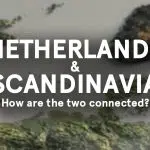 How the Dutch & Scandinavians Are Connected (Complete Guide)
How the Dutch & Scandinavians Are Connected (Complete Guide)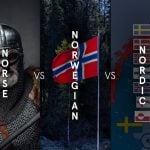 Norse vs. Norwegian vs. Nordic: Differences Explained
Norse vs. Norwegian vs. Nordic: Differences Explained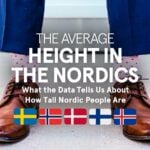 Average Height in the Nordics (Data & Graphs)
Average Height in the Nordics (Data & Graphs)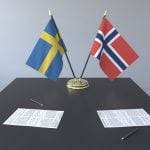 Should I Learn Swedish or Norwegian? (Answered with Data & Graphs)
Should I Learn Swedish or Norwegian? (Answered with Data & Graphs)

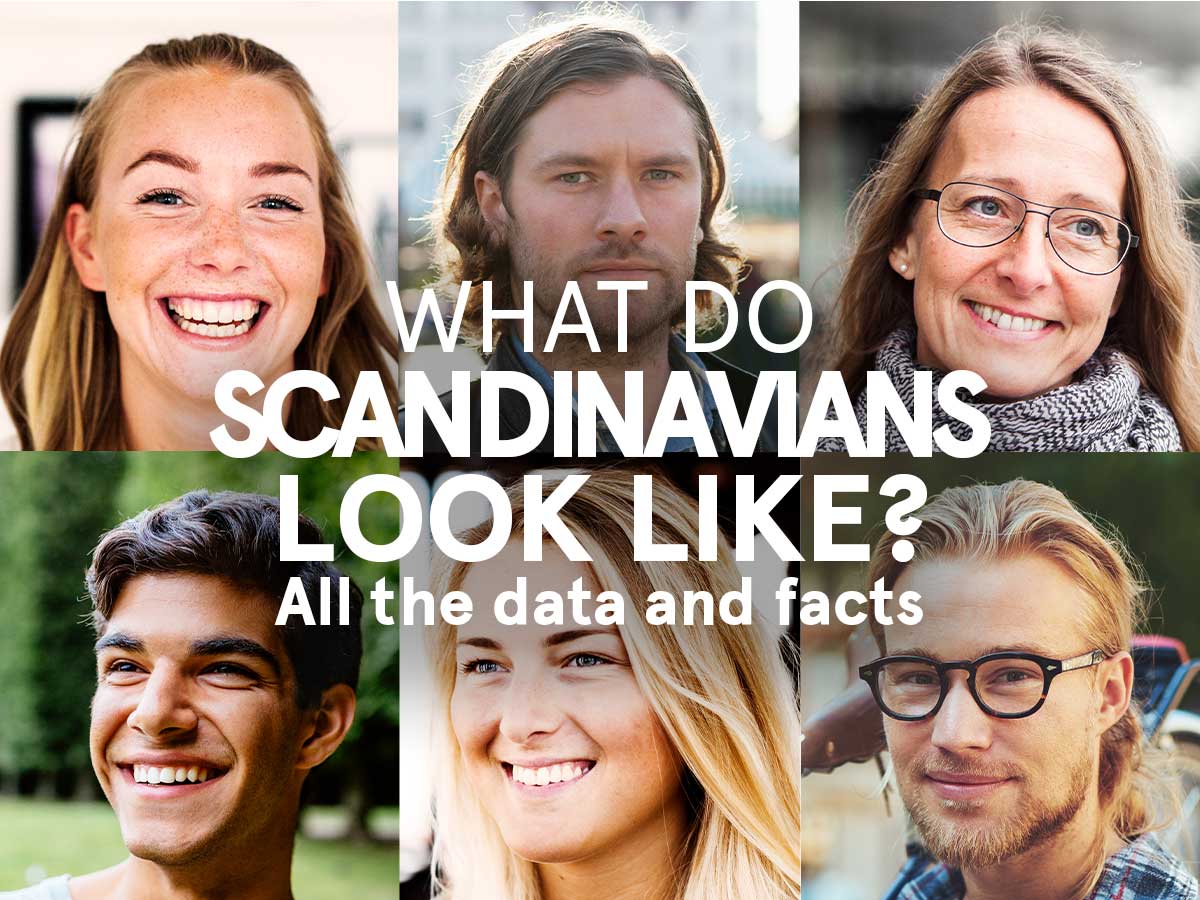



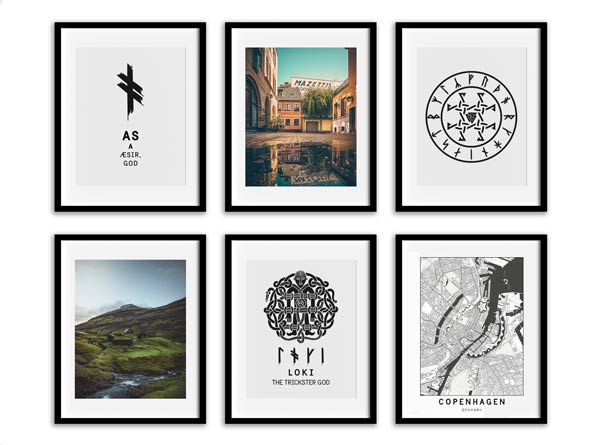
I love this site, and I don’t want to make sound as I’m complaining now but I must say that I am very skeptical of the “dark-skinned and blue-eyed people” who are said to be the first Scandinavians. Is the origin of this theory SVT’s “The first Swedes” ? I never heard of a darker skin mixing and become as white as we are today.
Again: love the site and the work behind with lots of information and I don’t mean to complain.
Thanks Jonna for your comment, and I’m happy to hear you enjoyed the article!
Yes the origins and visual characteristics of the first Scandinavians were discussed in the SVT article (https://www.svt.se/nyheter/vetenskap/de-var-de-forsta-svenskarna), but more specifically this theory comes from research by Mattias Johansson, professor of genetics at Uppsala University. It seems the research project is well-funded too (https://kaw.wallenberg.org/forskning/atlas-med-forhistoriskt-dna-ger-ny-bild-av-manniskans-ursprung), so they seem to have the best tools available to analyze this type of scientific data.
As far as I know, the advanced DNA analysis of skeletal remains scientists can do today has proven to be very reliable (the same scientific method has been used to establish the physical traits of Vikings also, and they seem to agree with written records), and it’s not so hard to imagine Scandinavians’ skin adapting from dark to light over a long period of time due to changing sunlight exposure, as we are all descendants of dark-skinned Africans (if we go even further back in time) no matter how light our skin color is today.
Either way, we are dealing with theories in the end so all we can do is to look at the data we have available and make the best and most logical assumptions we can.
Take care!
Karl
Read about Cheddar Man in the United Kingdom. Also dark-skinned with blue eyes with descendants still living in the area he was found. The descendants are Caucasians/white.
I am here because my paternal grandpa (and my great grandma as she blue-eyed as noted on a vessel’s records she was travelling on when on her way to visiting Sweden where most of her relatives were living, as only her father also lived in Bermuda) was Swedish and on ancestry.com I know the exact village of my Swedish descendants. My family and I are Bermudians.
Really interesting post!
It seems contradictory to put “non-prominent cheekbones” in bold at the beginning of the article, when the attractiveness summary near the end of the article says “Scientifically speaking, there are a couple of factors that could play in the Scandinavians’ favor as far as sexual selection and attractiveness go” and includes “High cheekbones” as one of the top 5 positive traits.
Another facial characteristic of Swedes in particular seems to be a lower lip that’s noticeably larger than the upper lip, giving the women especially a lovely “pouty” appearance.
As for skin pigmentation, I’m a 100% N. European (mostly Lithuanian, Swedish, German) person with darker skin, at least in summer, than a lot of “black” biracial celebs. I had always assumed Swedes had more melanin than the average European due simply to living near coasts with a lack of tree cover and lots of time spent on boats, so natural selection would favor individuals who can tolerate this lack of shade. I’m sure it’s more complex than that, as this article describes. Southern Scandinavian areas get a warm summer climate due to the Gulf Stream bringing in warm water diagonally from the Caribbean on essentially a constant conveyor belt. This allows inhabitants there to wear more skin-revealing clothing than other Europeans at similar latitudes, further contributing to their development of more easily tannable skin. It comes in handy for me here in Louisiana.
FYI : All humans descending from /originating from Africa have approximately 2%+ Neanderthal DNA EXCEPT AFRICANS! Nearly 0%!!
For 10 years, geneticists have told the story of how Neanderthals—or at least their DNA sequences—live on in today’s Europeans, Asians, and their descendants. Not so in Africans, the story goes, because modern humans and our extinct cousins interbred only outside of Africa. A new study overturns that notion, revealing an unexpectedly large amount of Neanderthal ancestry in modern populations across Africa. It suggests much of that DNA came from Europeans migrating back into Africa over the past 20,000 years.
“beauty is entirely objective”
I’m guessing you mean “subjective” as it seems everyone messes up these two terms. Objective is a measurable observation, subjective is an arbitrary opinion.
You are of course correct and it’s a pretty important distinction. So thanks for catching that Kai, and have a great weekend!
“If eyes were made for seeing,
Then Beauty is its own excuse for being.”
What about natural eyebrow shape? For example, are arched eyebrows more prevalent among Scandinavians than for other Caucasion groups?
Great site with quality based content. You’ve done a remarkable job in discussing. Check out my website Webemail24 about Data Mining and I look forward to seeing more of your great posts.
President Dwight D. Eisenhower allegedly had a face to face with extraterrestrials on February 20, 1954. and referred to them as, “Nordic’s,” as they looked, Scandinavian.
Strangely, my DNA is Scandinavian and there are no Scandinavians in my family history. After witnessing a UFO in the evening at the Showboat in Las Vegas, Nevada, back in the 60’s, my thoughts began to wonder about my existence and origin.
I just got back from a trip to Oslo, Norway, and Stockholm, Sweden.
During my visit, I was surprised by how few locals fit the “tall, white, Nordic” stereotype. In fact, my observation was often the opposite. Whenever I thought I saw someone who matched that description, they usually turned out to be German tourists or visitors from other European countries.
Interestingly, however, I did notice a lot of kindergarten children in Oslo who were predominantly blonde and blue-eyed.
“Notoriously curly-haired Swedish artist Magnus Uggla.”
“Category: Swedish people of Jewish descent”
https://en.wikipedia.org/wiki/Magnus_Uggla
I don’t believe having Jewish descent disqualifies you from being Swedish? Also, the Uggla family can trace their Swedish lineage back to at least 1515, so in my book they would be considered very Swedish. https://en.wikipedia.org/wiki/Uggla